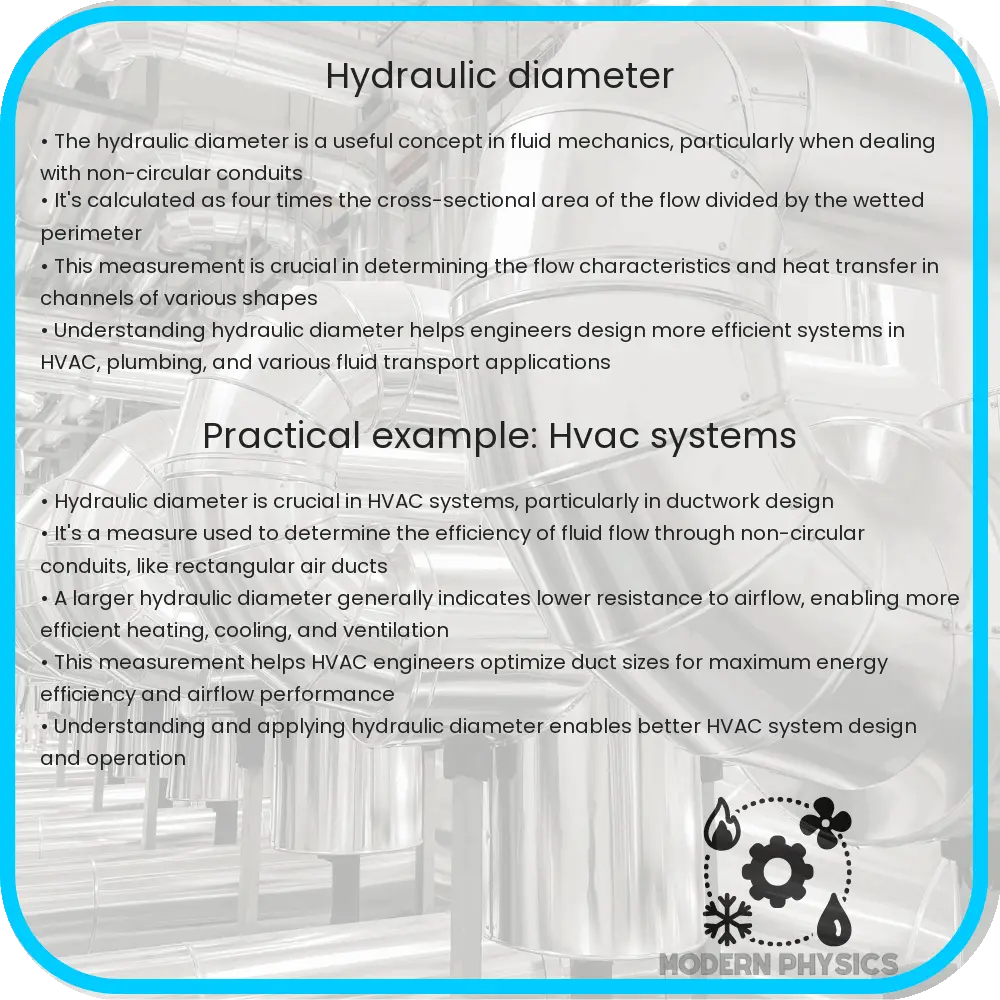Explore the crucial role of hydraulic diameter in fluid mechanics, its impact on flow analysis, efficiency, and design in various engineering fields.

Understanding Hydraulic Diameter: An Essential Tool for Flow Analysis in Engineering
The concept of hydraulic diameter plays a pivotal role in the field of fluid mechanics, especially when dealing with non-circular conduits. This parameter is crucial for analyzing flow characteristics, improving efficiency, and optimizing design in various engineering applications.
Definition and Calculation of Hydraulic Diameter
Hydraulic diameter, Dh, is defined as four times the hydraulic radius, which is the ratio of the cross-sectional area of the flow (A) to the wetted perimeter (P). Mathematically, it’s expressed as:
Dh = 4A/P
This formula allows for the translation of non-circular conduit flow characteristics into equivalent circular diameter terms, facilitating easier analysis and comparison.
Significance in Flow Analysis
In fluid mechanics, hydraulic diameter is used to evaluate the Reynolds number, a dimensionless quantity critical for determining the flow regime—laminar or turbulent. The Reynolds number is calculated as:
Re = ρVDh/μ
where ρ is the fluid density, V is the velocity of the fluid, and μ is the dynamic viscosity. By using the hydraulic diameter in this equation, engineers can assess the flow characteristics in non-circular ducts or pipes with a similar approach as for circular ones.
Impact on Efficiency and Design
The application of hydraulic diameter extends beyond flow analysis to influencing the efficiency and design of fluid systems. In heat exchanger design, for instance, an appropriate hydraulic diameter can enhance heat transfer efficiency. It’s also vital in the design of ducts in ventilation systems, where the hydraulic diameter can impact air flow and distribution.
Moreover, in sectors like chemical processing or wastewater treatment, where pipes and ducts of various shapes are common, understanding and applying the concept of hydraulic diameter is essential for optimizing fluid flow, reducing energy consumption, and enhancing overall system performance.
The next section will delve deeper into practical applications, including case studies and advanced considerations in the use of hydraulic diameter for flow analysis and system design.
Practical Applications and Advanced Considerations
The versatility of hydraulic diameter extends to numerous practical applications. In chemical engineering, it’s essential for designing reactors and pipelines where non-circular cross-sections are prevalent. Similarly, in the HVAC industry, the effective design of ductwork for optimal air distribution relies heavily on accurately calculating the hydraulic diameter.
Advanced considerations also come into play, particularly in complex flow systems. For instance, in multi-phase flows like those in oil and gas pipelines, the hydraulic diameter helps in predicting flow patterns and pressure drops, which are crucial for safe and efficient operations.
Case Studies: Hydraulic Diameter in Action
Real-world examples further illustrate the importance of hydraulic diameter. A notable case is the redesign of a wastewater treatment plant’s piping system. By recalculating the hydraulic diameter for the irregularly shaped pipes, engineers were able to reduce friction losses significantly, leading to energy savings and improved flow efficiency.
Another example is found in the aerospace industry. The design of air intakes and ventilation systems in aircraft often involves complex duct shapes. Utilizing the hydraulic diameter concept, engineers achieved more efficient air distribution, contributing to better environmental control systems onboard.
Conclusion: The Integral Role of Hydraulic Diameter
In conclusion, the hydraulic diameter is more than just a theoretical concept; it’s a fundamental tool in fluid mechanics with wide-ranging applications. Its role in transforming complex, non-circular flow problems into manageable analyses cannot be overstated. From enhancing energy efficiency in industrial systems to optimizing design in aerospace and HVAC systems, the hydraulic diameter proves to be an invaluable parameter.
Understanding and applying the principles of hydraulic diameter not only leads to better design and operational efficiency but also paves the way for innovative solutions in tackling modern engineering challenges. As technology advances and systems become more complex, the hydraulic diameter will undoubtedly remain a cornerstone in the field of fluid dynamics and system design.
